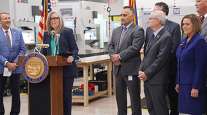Special to Transport Topics
Driving Simulators Help Trucking Companies Recruit New Talent
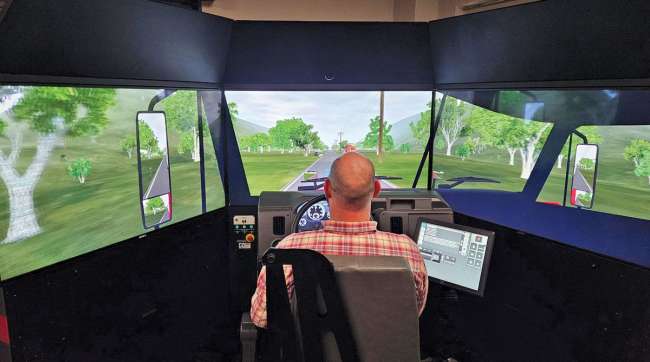
[Stay on top of transportation news: Get TTNews in your inbox.]
For CDL trainers and some fleets, truck driving simulators are among the most innovative and realistic ways to teach new drivers. Although they don’t fully replicate true life behind the wheel, the use of simulators throughout the industry is gradually increasing. They serve as an ideal way to reach a younger generation of drivers.
Simulators are equipped with high-definition graphics and wraparound sound systems providing a variety of driving scenarios. A trainer can analyze driving habits, track (and break) bad habits, and note if a driver is wasting fuel. Users say the technology is helpful for training new and experienced drivers.
Trainers who use simulators are quite enthusiastic about them, said Russell Hoyt, director and co-founder of MG Truck Driving School in Glendale, Ariz. He first discovered simulators at a new equipment conference he attended about a year and a half ago and was impressed with what he learned.
“When we get a driver trained on a simulator, they really understand the basics and fundamentals of driving a truck. It is remarkable that technology can do such things,” said Hoyt, who formed a company to build new simulators to mimic real-time situations like jackknifing. “In real life, you can’t practice a wreck, but you can practice avoiding it by doing certain maneuvers like controlled driving and emergency braking.”
He also noted that they will be adapting AI and virtual reality into the product, where a driver can even look out the window. Hoyt added there has been interest from local police and sanitation departments, and he plans to introduce his simulators to the Arizona Trucking Association.
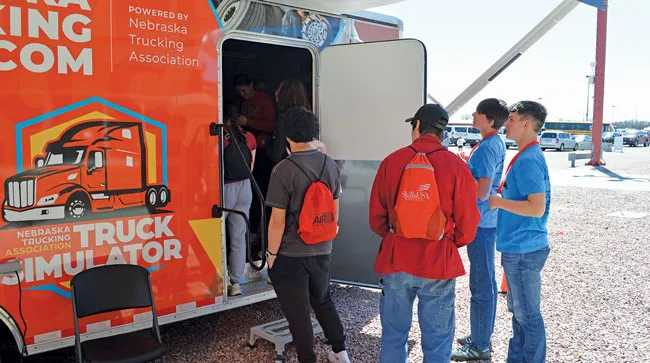
The Nebraska Trucking Association's mobile simulator. (Nebraska Trucking Association)
The Nebraska Trucking Association utilizes a mobile simulator mounted in a cargo trailer. Kent Grisham, president and CEO, said its primary use is workforce development outreach.
“We are out there targeting especially younger audiences to talk about career opportunities in trucking, including the safety aspect and development of technology in the trucking industry — those messages have an appeal for younger folks,” he said.
Grisham added that many community colleges across Nebraska, where the bulk of truck driving training takes place in the state, have simulators on campus. There, students can practice driving between classroom sessions and actually being out on the road.
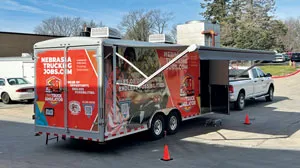
Many community colleges across Nebraska have simulators on campus, Grisham said. (Nebraska Trucking Association)
“You can’t certify a student driver in any way using a simulator, but you can certainly reinforce the driving skills,” he said. “If you want them to practice driving on icy roads, it is much better to practice in a simulator than to take them out in a blizzard.”
A simulator, Grisham said, can emulate driving in high winds and other conditions common in the Midwest.
“We’ve had literally hundreds of experienced truck drivers behind the wheel of our simulator, and they all give it very high marks for realistically portraying what it’s like on the road,” he said. “It is good representation of the road, which is important.”
RELATED: FMCSA Grants $3.5 Million for CDL Training at 27 Schools
UPS rolled out driving simulators in 2020. They are now deployed nationwide in 11 Integrad training schools as well as stand-alone units in 42 operations, with new updates and trainings released quarterly. The fleet, which ranks No. 1 on the Transport Topics Top 100 list of the largest for-hire carriers in North America, also operates a mobile training unit. The company developed the driving simulator completely in-house, said Tristan Christensen, UPS’ content development director for U.S. Operations Training.
“The UPS driving simulator is built inside an actual UPS package car, which gives the realistic feel of the actual environment,” she said. “It has monitors that are in the front of the UPS package car, and we’re able to display 360-degree video experiences that are developed off actual roadways, with very realistic driving scenes overlaid with graphics.”
She added that drivers are trained in space and visibility, safe driving methods and defensive driving techniques. They are also developing more targeted training by simulating high-risk scenarios, such as intersections and distracted pedestrians and motorists.
Advantages of In-House Simulators
Fremont Contract Carriers in Fremont, Neb., has an in-house simulator, bought at auction, which it uses for upfront assessment and ongoing training.
Transtex CEO Mathieu Boivin discusses the environmental sustainability of auxiliary power units. Tune in above or by going to RoadSigns.ttnews.com.
Previously, the company only hired drivers with at least two years of experience but recognized that it was missing out on qualified, younger drivers. For that reason, the company developed an in-house training program geared toward drivers who just got their CDL.
“We thought, ‘Why don’t we assess their skills instead of passing on them, and maybe we just put them out with a trainer for a couple of days, weeks or months?’” said Tim McCormick, president and CEO. “That is where the simulator becomes that tool to evaluate some of their skills. We still take them out on road tests before we qualify them, but this gives us an indication of the skills they have up front.”
The simulator also is used for rehabilitation and continued training. For example, scenarios are created to replicate real-life situations, such as driving in poor weather conditions. Should a driver have an accident due to weather, for example, McCormick said that they utilize the simulator to evaluate that driver’s skills by replicating the scenario and having them practice.
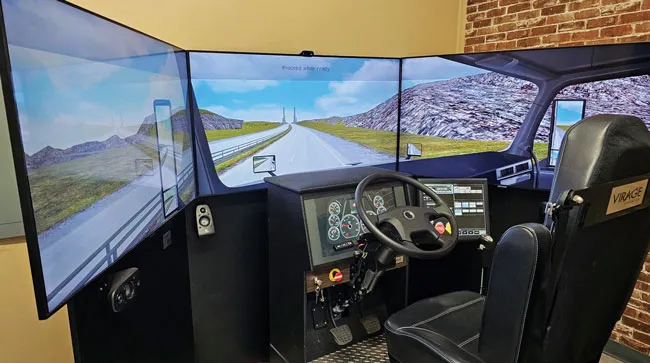
Simulators are equipped with high-definition graphics with wraparound sound systems providing a variety of driving scenarios. (MG Truck Driving School)
Barriers to Widespread Adoption
Grisham said that some larger carriers have built-in truck driving simulators in classroom settings inside their facilities and even offer incentives for employees to use them. At this point, however, simulators used for training are still niche versus standard.
This is in part because simulators can be quite costly, particularly for smaller carriers. Mobile units, such as the one owned by the Nebraska Trucking Association, are a way to bridge that gap. Fremont was lucky to obtain a simulator at auction for a greatly reduced price. “Portable ones have become more mainstream because they are more affordable for a carrier like us who wants to get into using that technology,” said McCormick.
Hoyt believes that one of the keys to this technology becoming more mainstream is lowering the cost without losing quality. Still, he believes it is a “no-brainer” purchase, as a simulator has no operating costs and does not have to be insured.
“It really does make a superior driver,” he said. “If you had two average people with the same ability, one trained on it and one not, I guarantee you the one trained on it will be 10 times the driver. I have seen the proof over and over and over.”
RELATED: CDL Schools, Driver Training Programs Focus on the Right Fit
Space is another consideration, particularly for smaller businesses, as a unit can occupy a large footprint. But mobile units could be a solution for those who do not wish to make the investment just yet, at least for occasional training or refresher courses. Grisham said that he has many requests from association members to bring the mobile unit onsite for training purposes.

Grisham
“Members will work with us to develop scenarios they’d like their drivers to practice,” he said. “We can bring the trailer to their shop or they can come to our office building.”
Another potential barrier to widespread adoption of this technology is an old-school mentality, with some people unwilling to embrace something new, and others thinking that simulators are akin to video games.
“That mindset is still rampant throughout the industry, but statistics don’t lie and numbers don’t lie,” Hoyt said. “When you cut emotions and personal biased feelings out of it, you see accident rates drop 80%.”
Return on Investment
Although he said it’s a little soon to see if the simulator is having a meaningful, quantifiable return on investment, McCormick did note that recruiting has increased quite a bit since they started using it, as they are now comfortable bringing in less experienced drivers.
“It helps us engage with our drivers as well, and that is probably one of the more important pieces of it,” he said. “The simulator allows us to have a conversation and gets those drivers to be open to training. It eases the tension so you can make the training a little more agreeable.”
Want more news? Listen to today's daily briefing above or go here for more info
Christensen said that since the simulators have been introduced, there’s been increased interest from part-time UPS workers who are considering getting their licenses. “We were able to see a 20% improvement in our graduation rate and on-road scores. Drivers were lining up at the simulator to get that additional practice,” she said.
Even if the ROI isn’t directly measurable from a financial standpoint, it can be quantifiable from an accident reduction standpoint. According to Hoyt, besides simulator training reducing the accident rate for new drivers by 80%, it also can help save equipment. He said that damage to clutches can be exponential for new drivers, who often have trouble double clutching.
“You can lose $5-6 thousand quickly with someone who is new, but we can put a student in a simulator and teach them how to clutch and shift, as realistically as possible, so by the time they get into a real semi, they’d know how to drive,” he said. “That saves on wear and tear and operating expenses, and plus they are saving fuel.”



